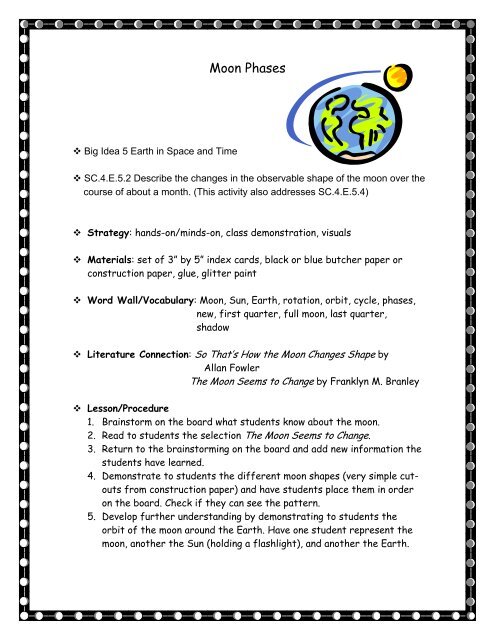SC.4.E.5.2 Moon Phases - the Science Home Page
SC.4.E.5.2 Moon Phases - the Science Home Page
SC.4.E.5.2 Moon Phases - the Science Home Page
Create successful ePaper yourself
Turn your PDF publications into a flip-book with our unique Google optimized e-Paper software.
<strong>Moon</strong> <strong>Phases</strong><br />
Big Idea 5 Earth in Space and Time<br />
<strong>SC.4.E.5.2</strong> Describe <strong>the</strong> changes in <strong>the</strong> observable shape of <strong>the</strong> moon over <strong>the</strong><br />
course of about a month. (This activity also addresses SC.4.E.5.4)<br />
Strategy: hands-on/minds-on, class demonstration, visuals<br />
Materials: set of 3” by 5” index cards, black or blue butcher paper or<br />
construction paper, glue, glitter paint<br />
Word Wall/Vocabulary: <strong>Moon</strong>, Sun, Earth, rotation, orbit, cycle, phases,<br />
new, first quarter, full moon, last quarter,<br />
shadow<br />
Literature Connection: So That’s How <strong>the</strong> <strong>Moon</strong> Changes Shape by<br />
Allan Fowler<br />
The <strong>Moon</strong> Seems to Change by Franklyn M. Branley<br />
Lesson/Procedure<br />
1. Brainstorm on <strong>the</strong> board what students know about <strong>the</strong> moon.<br />
2. Read to students <strong>the</strong> selection The <strong>Moon</strong> Seems to Change.<br />
3. Return to <strong>the</strong> brainstorming on <strong>the</strong> board and add new information <strong>the</strong><br />
students have learned.<br />
4. Demonstrate to students <strong>the</strong> different moon shapes (very simple cutouts<br />
from construction paper) and have students place <strong>the</strong>m in order<br />
on <strong>the</strong> board. Check if <strong>the</strong>y can see <strong>the</strong> pattern.<br />
5. Develop fur<strong>the</strong>r understanding by demonstrating to students <strong>the</strong><br />
orbit of <strong>the</strong> moon around <strong>the</strong> Earth. Have one student represent <strong>the</strong><br />
moon, ano<strong>the</strong>r <strong>the</strong> Sun (holding a flashlight), and ano<strong>the</strong>r <strong>the</strong> Earth.
6. Have “moon student” orbit <strong>the</strong> Earth slowly while “sun student” shines<br />
light on moon. Teacher must help student hold flashlight at correct<br />
angle so students can see <strong>the</strong> different shades created at different<br />
angles.<br />
7. Create a border strip around <strong>the</strong> classroom or one wall with dark-blue<br />
or black butcher paper (construction paper works well also). Cut strips<br />
of paper about five inches high and place where students can reach on<br />
walls.<br />
8. Label with sign such as <strong>Moon</strong> Watch or <strong>Moon</strong> <strong>Phases</strong>. Have students<br />
glue some foil stars or glitter paint to create a night sky.<br />
Divide <strong>the</strong> students in groups and have <strong>the</strong>m draw and label <strong>the</strong><br />
different <strong>Moon</strong> phases on 3” by 5” index cards. Have students place<br />
<strong>the</strong>m on strips in <strong>the</strong> correct sequence.<br />
Assessment<br />
Assess understanding by having <strong>the</strong> students create <strong>the</strong>ir own moon-phases<br />
activity (see pages attached). Students may also keep a moon calendar for a<br />
month to observe <strong>the</strong> daily changes and patterns.<br />
<strong>Moon</strong>
















